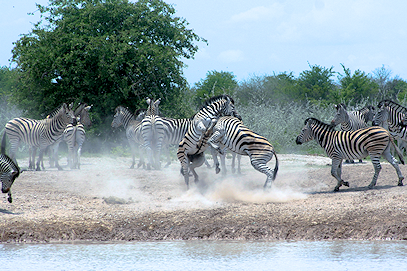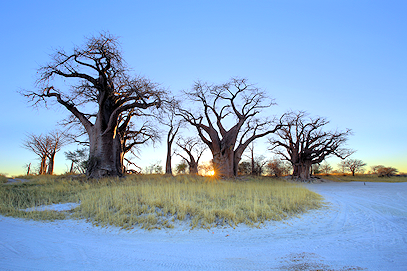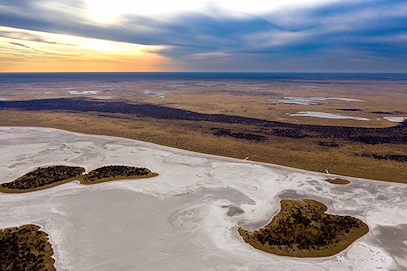- USD
- EUR
- GBP
- AUD
- CAD
- ZAR
Nxai Pan National Park covers around 2500 square kilometers and has a larger permanent animal population than the Makgadikgadi Pans. It is a destination for some. It offers unique sights, like Baines Baobabs, that avid nature lovers will find fascinating on a safari in Botswana.
Need Advice?Several palm-speckled islands dot the vast expanse of the pans. One of the islands is home to a cluster of ancient baobab trees known as Baines Baobabs - a truly mesmerizing sight. During the rainy season - November to April - large herds of wildebeest, zebra, gemsbok, springbok, and eland converge on the area.

In addition to wildlife and islands, there are several noteworthy attractions. One is the "old trek route," a trail used in the 1950s and 1960s as a shortcut through Ngamiland to Kazungula via Pandamatenga. During this time, many boreholes were drilled to water the cattle and men on their long trek. Some of these boreholes now provide water for wildlife, creating unique oases that attract large animal concentrations in the dry season.
The pan is not a traditional safari destination. Still, it has the advantage of very little to no vegetation cover, making it possible to capture images of various antelope and predator species unhindered. Nxai also offers Bains Baobabs, which create a fantastic feature against a backdrop of the desolate salt pan.
A nature walk in the company of a San Bushman will offer unrivaled insight into the natural world. The ancestors of these hunter-gatherers have inhabited the region for thousands of years. During the detailed interaction, animal behavior, signs, and tracks left by various species will come under the spotlight.
Observing the antics of a meerkat gang is informative, exciting, and delightful. These tiny critters have an evolved social structure, with each playing a part in gathering food, tending the young, and guard duty. When a sentry raises the alarm, the whole mob disappears into their borrow at lightning speed.
As with all other safari destinations, the rewarding experiences revolve around viewing animals in their environment and an immersion in the natural world.



Guests will be met at OR Tambo International and transferred to a flight to Maun Airport in Botswana. It is a one-hour light aircraft flight from Maun Airport to the airstrip near Nxai Pan. Remember that light aircraft flights can be bumpy, especially the landings – if you are uncomfortable with small planes, please speak to an African Sky consultant, so we can make other arrangements.
The park is about 500km north of Gaborone. The arduous drive covers beautiful landscapes and is a great way to get to know the area. African Sky guests, however, will be transported directly to the park in a light aircraft, where, upon arrival, an experienced guide will transport you in a 4x4 vehicle to the lodge.
There is no wrong time to visit this wilderness area, but the rainy season would be the best. This season lasts from November to April and will give you more opportunities to view the wildlife. During this time, visitors should be wary of roads blocked due to floods; our team will always ensure that you travel on safe roads.
During the dry season, from May to October, there are other perks to visiting the Nxai Pan National Park. Traveling is more straightforward, as the absence of rain means fewer road complications. During this time, you can also experience the remoteness of the desert, with fewer tourists interrupting the peace, and you can watch the pulse-quickening interaction between predator and prey.
The pans started forming more than five million years ago when the rivers that flowed into the great lake changed direction. Nxai Pan was declared a national park in 1970. In 1992, boundaries were expanded to include the area where Baines Baobabs stand. Today, the Nxai Pan National Park is 2578 square kilometers in extent. "Nxai" is a hook that removes spring hares from their holes.
In 1862, Thomas Baines and his comrade John Chapman traveled through the Nxai Pan in ox wagons. They were traveling from Namibia to Victoria Falls. They made a pit stop at Nxai Pan, close to the group of baobabs. They were so amazed by these "upside down trees" that Baines decided to paint them - the painting became famous and brought the attention of many to this beautiful natural site.
Once the rainy season starts in November or December, thousands of animals migrate in herds to the Nxai Pan National Park. The park transforms from an arid wasteland into a "Garden of Eden." The waterhole, 2km from the main entrance, is the best place to see all these animals interacting.
Permanent residents of the area surrounding the waterhole are lion, giraffe, kudu, impala, ostrich, fascinating birdlife, large numbers of springbok, a sizable jackal population, bat-eared fox, and numerous smaller creatures. Staggering numbers of animals join these residents during the rainy season as herds of thousands of zebra, gemsbok, and wildebeest migrate to this area.
In essence, the park is an arid wasteland during the dry season from May to October, when it becomes so dry that animals have to fight for food and water. There are different types of vegetation in various parts of the park. In the northern part of the park, the soil tends to be almost clay-like because of the high moisture present; trees like Mopane grow here. Most of the park is void of trees and covered in short grass only.
Game viewing is best in the rainy season, from November to April, as the zebra migration reaches the Nxai Pan. It includes around 25 000 zebras. Other animals you might see include wildebeest, springbok, lions, cheetahs, and many more.
Baines Baobabs is a sight you must see when visiting the pan. It is a cluster of seven baobab trees in the middle of a dry salt pan. Some of these trees are estimated to be over 4 000 years old. They were stumbled upon by Thomas Baines, who immortalized the image on canvas - a picture that later became iconic. This cluster of trees is a national monument and still looks the same as when Baines painted it in the 1800s. Birdwatching is also a favored activity for visitors to Nxai Pan, with the chance to observe great flocks of flamingos and pelicans, as well as Kori bustards, korhaans, and red-necked falcons.





This website uses cookies. To learn more about how we use cookies, please view our Privacy Policy. By clicking "I Accept" on this banner, you consent to the use of cookies unless you have disabled them.